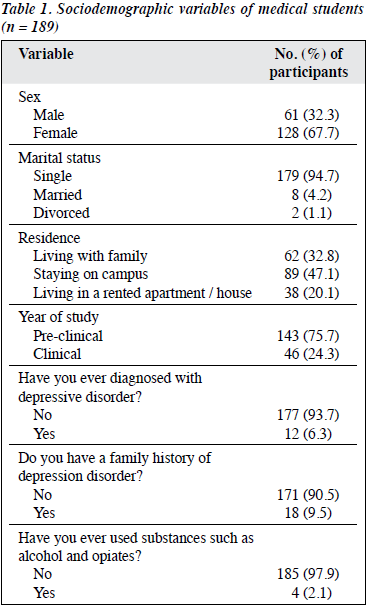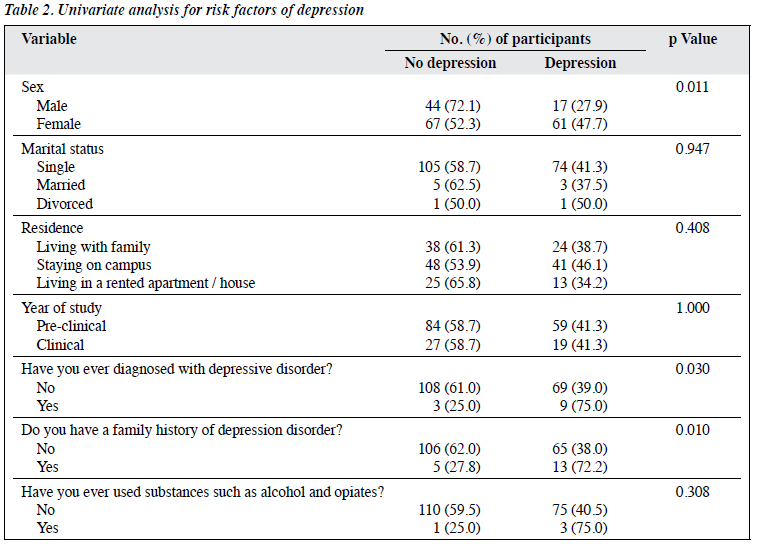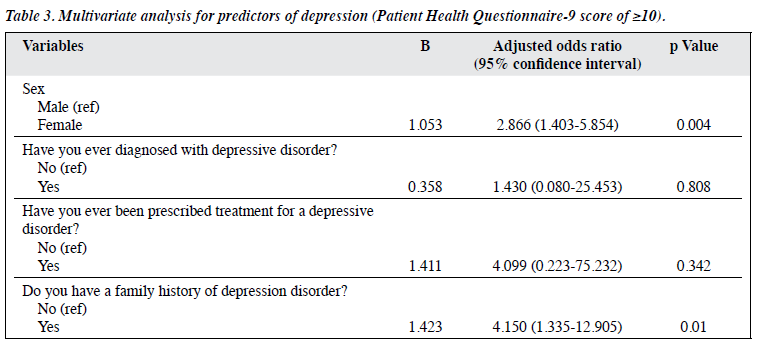East Asian Arch Psychiatry 2020;30:28-31 | https://doi.org/10.12809/eaap1882
ORIGINAL ARTICLE
Mohammed Al-Maashani, MD, Psychiatry Residency Training Program, Oman Medical Specialty Board, Muscat, Oman
Naser Al-Balushi, MD, Psychiatry Residency Training Program, Oman Medical Specialty Board, Muscat, Oman
Mohammed Al-Alawi, MD, Psychiatry Residency Training Program, Oman Medical Specialty Board, Muscat, Oman; Department of Behavioral Medicine, College of Medicine & Health Sciences, Sultan Qaboos University, Muscat, Oman
Hassan Mirza, MD, MSc, Department of Behavioral Medicine, College of Medicine & Health Sciences, Sultan Qaboos University, Muscat, Oman Salim Al-Huseini, MD, Psychiatry Residency Training Program, Oman Medical Specialty Board, Muscat, Oman
Manal Al-Balushi, MD, Psychiatry Residency Training Program, Oman
Medical Specialty Board, Muscat, Oman
Yousif Obeid, MD, Department of Behavioral Medicine, College of Medicine & Health Sciences, Sultan Qaboos University, Muscat, Oman
Sachin Jose, MSc, Research and Statistics, Oman Medical Specialty Board, Muscat, Oman
Nasser Al-Sibani, Department of Behavioral Medicine, College of Medicine & Health Sciences, Sultan Qaboos University, Muscat, Oman
Samir Al-Adawi, MD, Department of Behavioral Medicine, College of Medicine & Health Sciences, Sultan Qaboos University, Muscat, Oman
Address for correspondence: Dr Naser Al Balushi, Psychiatry Residency Training Program, Oman Medical Specialty Board, Muscat, Sultanate of Oman. Email: naser.albalushi@hotmail.com
Submitted: 25 March 2018; Accepted: 26 March 2019
Abstract
Background: Depressive symptoms are common among medical students. The aim of the present study was to determine the prevalence and risk factors of depressive symptoms among medical students in Sultan Qaboos University in Oman.
Method: A cross-sectional study was conducted among a random sample selected from 1041 medical students at Sultan Qaboos University, Oman. The Patient Health Questionnaire-9 (PHQ-9) was used to screen for depressive symptoms. A logistic regression model was used to determine risk factors for depressive symptoms.
Results: Of 197 medical students selected, 189 (61 men and 128 women) responded. The PHQ-9 results showed that the prevalence of depressive symptoms was 41.3%. In multivariate analysis, female students were more likely than male students to develop depression (adjusted odds ratio = 2.866, p = 0.004). Medical students with a family history of depression were more likely to develop depression than those without a family history of depression (adjusted odds ratio = 4.150, p = 0.014).
Conclusion: Depressive symptoms are common among medical students in Sultan Qaboos University. Risk factors for depressive symptoms are female sex and family history of depression.
Key words: Depression; Oman; Patient Health Questionnaire; Students, medical
Introduction
Psychological distress among college students is increasingly recognised.1 However, depressive symptoms among medical students often go unrecognised, compared to the general population.2 This ‘silent epidemic’ has been reported in medical schools in Gulf Cooperation Council countries.3 A meta-analysis reported that the prevalence of depressive symptoms among medical students in Gulf Cooperation Council countries was higher than the international trend.4 Moreover, these medical students have the highest dropout rate.5 In Oman, approximately 17% of medical students have depressive symptoms.6 The present study aimed to determine the prevalence and risk factors of depressive symptoms among medical students in Sultan Qaboos University in Oman.
Methods
This study was approved by the Ethics Committee of the College of Medicine at Sultan Qaboos University Hospital (MREC#893) and was conducted from August to December 2015 At the time of the study, there were 1041 medical students from all six academic years at the College of Medicine and Health Sciences of Sultan Qaboos University.7
Based on the 17% prevalence of depression among medical students in Sultan Qaboos University,6 the minimum sample size to have a power level of 80% was calculated as 171, with a type-1 error of 5% (alpha = 0.05) and significance level of 95%. Students were selected at random using a software randomizer; a sample of 197 was generated to allow for non-responses. Because stress level may differ among medical student year-groups,8 the present cohort was categorised as either pre-clinical (years 1 to 4) or clinical (years 5 to 6).
The outcome measure was the self-administered Patient Health Questionnaire-9 (PHQ-9). The PHQ-9 contains items adopted from the DSM-IV and aids in the diagnosis of depressive symptoms and their severity. It has been psychometrically validated in different settings (including primary, secondary, and tertiary), cultures, and samples. Its performance was comparable to that of doctor-administered scales in diagnosing depression. In a validation study in Oman, a cut-off score of ≥10 had a likelihood ratio of 10 for a positive test result9. In the present study, the same cut-off score was used for the presence of depressive symptoms. A total score of 10 to 14 was considered moderate depression, 15 to 19 moderately severe depression, and 20 to 27 severe depression, in accordance with the DSM-IV.
Those with or without depression were compared using Chi-squared test or Fisher’s exact test for categorical variables. Associations between sociodemographic and clinical variables and the presence of depression were determined using univariate and multivariate analyses. Variables associated with depression in the univariate analysis were entered into a stepwise backward logistic regression model to determine the correlates of depression and to adjust for confounders. A two-tailed significance level was set at 0.05. Statistical analysis was carried out using SPSS (Windows version 22.0; IBM Corp, Armonk [NY], United States).10
Results
Of 197 medical students selected, 189 (61 men and 128 women) responded (Table 1). Of them, 94% were single; 75.7% were preclinical students and 24.3% were clinical students. 93.7% has never diagnosed with depressive disorder. 90.5% had no family history of depressive disorder. 97.9 % has never used alcohol or opiates. According to PHQ-9 results, the prevalence of depressive symptoms was 41.3%.
In univariate analysis, female sex (p = 0.01), previous diagnosis with depression (p = 0.03), and a family history of depression (0.01) were risk factors for depression among medical students (Table 2).
In multivariate analysis, female students were more likely to develop depression than male students (adjusted odds ratio = 2.866, 95% confidence interval = 1.403-5.854, p = 0.004, Table 3). Medical students with a family history of depression were more likely to develop depression than those without a family history of depression (adjusted odds ratio = 4.150, 95% confidence interval = 1.335-12.905, p = 0.014, Table 3).
Discussion
In a meta-analysis of 167 studies from 43 countries involving 116 628 people, the prevalence of depression and depressive symptoms was 27.2%.8 In Oman, the prevalence has ranged from 11.4%6 to 27.7%.7 In Saudi Arabia, the prevalence was 46.2% to 48.2%.11 In United Arab Emirates, the prevalence was 28.6%.12 In Bahrain, 19%13 to 40%14 of medical student were reported to have depressive symptoms. In the present study, the prevalence of depressive symptoms was 41.3%. The discrepancy could be due to case ascertainment bias, heterogeneity in the methodology, the healthcare system, and cultural differences.8 Arab culture discourages expression of emotion. The PHQ-9 is designed to solicit the ‘cognitive’ aspect of depression rather than ‘somatic’ types, which are rife as idiom of distress in Arab populations. Nonetheless, the present study indicated that depression is rife among medical students in terms of the PHQ-9, consistent with a meta-analysis of 77 studies involving 62 728 medical students that suggested that depressive symptoms are more common among medical students in Gulf Cooperation Council countries than elsewhere.4
In multivariate analysis, female students had higher odds of having depressive symptoms, consistent with previous studies on the general and college populations.4,8
Family history of depression also plays a significant role in the development of depressive symptoms, consistent with a meta-analysis that supports temporal relationship between depressive symptoms and family history of depressive illness.15 In previous studies in Gulf Cooperation Council countries, determinants of depressive illness included burnout, year of study, sex, relationship with peers, and academic performance.11,16
This study has several limitations. First, the study was cross-sectional, so the results cannot be used to isolate the cause and effect. Second, self-administered checklists are inferior to gold-standard interview. Third, other factors were not explored such as socioeconomic status, contact with family and/or relatives, academic performance, history of re- sitting examinations or repeating, and history of self-harm. Future studies should use a more robust methodology, and other potentially modifiable factors should be investigated.
Conclusion
Depressive symptoms are common among medical students in Sultan Qaboos University. Risk factors for depressive symptoms are female sex and family history of depression.
Declaration
The authors have no conflict of interest to disclose. No financial support was received.
References
- Hunt J, Eisenberg D. Mental health problems and help-seeking behavior among college students. J Adolesc Health 2010;46:3-10.
- Dyrbye LN, Thomas MR, Shanafelt TD. Systematic review of depression, anxiety, and other indicators of psychological distress among U.S. and Canadian medical students. Acad Med 2006;81:354- 73.
- Hamdy H, Telmesani AW, Wardy NA, Abdel-Khalek N, Carruthers G, Hassan F, et al. Undergraduate medical education in the Gulf Cooperation Council: a multi-countries study (Part 2). Med Teach 2010;32:290-5.
- Puthran R, Zhang MW, Tam WW, Ho RC. Prevalence of depression amongst medical students: a meta-analysis. Med Educ 2016;50:456- 68.
- Maher BM, Hynes H, Sweeney C, Khashan AS, O’Rourke M, Doran K, et al. Medical school attrition-beyond the statistics a ten year retrospective study. BMC Med Educ 2013;13:13.
- Al-Busaidi Z, Bhargava K, Al-Ismaily A, Al-Lawati H, Al-Kindi R, Al-Shafaee M, et al. Prevalence of depressive symptoms among university students in Oman. Oman Med J 2011;26:235-9.
- Albarwani S, Al-Saadoon M, Al-Rawas O, Al-Yaarubi S, Al-Abri R, Al-Lamki L, et al. Reflections on the academic accreditation of the MD programme of the College of Medicine & Health Sciences, Sultan Qaboos University, Oman. Sultan Qaboos Univ Med J 2014;14:e7- e11.
- Rotenstein LS, Ramos MA, Torre M, Segal JB, Peluso MJ, Guille C, et al. Prevalence of depression, depressive symptoms, and suicidal ideation among medical students: a systematic review and meta- analysis. JAMA 2016;316:2214-36.
- Al-Ghafri G, Al-Sinawi H, Al-Muniri A, Dorvlo AS, Al-Farsi YM, Armstrong K, et al. Prevalence of depressive symptoms as elicited by Patient Health Questionnaire (PHQ-9) among medical trainees in Oman. Asian J Psychiatr 2014;8:59-62.
- IBM SPSS statistics for windows, version 20.0. 2013.
- Al-Faris EA, Irfan F, Van der Vleuten CP, Naeem N, Alsalem A, Alamiri N, et al. The prevalence and correlates of depressive symptoms from an Arabian setting: a wake up call. Med Teach 2012;34(Suppl 1):S32- 6.
- Ahmed I, Banu H, Al-Fageer R, Al-Suwaidi R. Cognitive emotions: depression and anxiety in medical students and staff. J Crit Care 2009;24:e1-7.
- Abdelaziz AMY, Alotaibi KT, Alhurayyis JH, Alqahtani TA, Alghamlas AM, Algahtani HM, et al. The association between physical symptoms and depression among medical students in Bahrain. Int J Med Educ 2017;8:423-7.
- Mahroon ZA, Borgan SM, Kamel C, Maddison W, Royston M, Donnellan C. Factors associated with depression and anxiety symptoms among medical students in Bahrain. Acad Psychiatry 2018;42:31-40.
- Sullivan PF, Neale MC, Kendler KS. Genetic epidemiology of major depression: review and meta-analysis. Am J Psychiatry 2000;157:1552- 62.
- Al-Alawi M, Al-Sinawi H, Al-Qubtan A, Al-Lawati J, Al-Habsi A, Al- Shuraiqi M, et al. Prevalence and determinants of burnout syndrome and depression among medical students at Sultan Qaboos University: a cross-sectional analytical study from Oman. Arch Environ Occup Health 2019;74:130-9.





